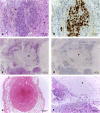Feasibility of the chick chorioallantoic membrane model for preclinical studies on tumor radiofrequency ablation
- PMID: 37749303
- PMCID: PMC10519884
- DOI: 10.1186/s41747-023-00368-3
Feasibility of the chick chorioallantoic membrane model for preclinical studies on tumor radiofrequency ablation
Abstract
Background: We evaluated the feasibility of a chick chorioallantoic membrane (CAM) tumor model for preclinical research on tumor radiofrequency ablation (RFA).
Methods: Fertilized chicken eggs were incubated and divided into five cohorts: RFA for 30 s (n = 5), RFA for 60 s (n = 5), RFA for 120 s (n = 4), sham (n = 8), and controls (n = 6). Xenografting using pancreatic neuroendocrine tumor cells of the BON-1 cell line was performed on embryonic day (ED) 8. The RFA was performed on ED 12. Survival, stereomicroscopic observations, and histological observations using hematoxylin-eosin (H&E) and Ki67 staining were evaluated.
Results: The survival rates in the 30-s, 60-s, and 120-s, sham and control cohort were 60%, 60%, 0%, 100%, and 50%, respectively. Signs of bleeding and heat damage were common findings in the evaluation of stereomicroscopic observations. Histological examination could be performed in all but one embryo. Heat damage, bleeding, thrombosis, and leukocyte infiltration and hyperemia were regular findings in H&E-stained cuts. A complete absence of Ki67 staining was recorded in 33.3% and 50% of embryos in the 30-s and 60-s cohorts that survived until ED 14, respectively.
Conclusions: The CAM model is a feasible and suiting research model for tumor RFA with many advantages over other animal models. It offers the opportunity to conduct in vivo research under standardized conditions. Further studies are needed to optimize this model for tumor ablations in order to explore promising but unrefined strategies like the combination of RFA and immunotherapy.
Relevance statement: The chick chorioallantoic membrane model allows in vivo research on tumor radiofrequency ablation under standardized conditions that may enable enhanced understanding on combined therapies while ensuring animal welfare in concordance with the "Three Rs."
Key points: • The chorioallantoic membrane model is feasible and suiting for tumor radiofrequency ablation. • Radiofrequency ablation regularly achieved reduction but not eradication of Ki67 staining. • Histological evaluation showed findings comparable to changes in humans after RFA. • The chorioallantoic membrane model can enable studies on combined therapies after optimization.
Keywords: Chickens; Chorioallantoic membrane; Neuroendocrine tumors; Radiofrequency ablation; Radiology (interventional).
© 2023. European Society of Radiology (ESR).
Conflict of interest statement
The authors declare that they have no competing interests.
Figures



Similar articles
-
Chick chorioallantoic membrane model as a preclinical platform for cryoablation studies.Eur Radiol Exp. 2025 May 27;9(1):56. doi: 10.1186/s41747-025-00592-z. Eur Radiol Exp. 2025. PMID: 40425925 Free PMC article.
-
Evaluation of a bipolar-cooled radiofrequency device for ablation of bone metastases: preclinical assessment in porcine vertebrae.Spine J. 2014 Feb 1;14(2):361-70. doi: 10.1016/j.spinee.2013.08.041. Epub 2013 Nov 22. Spine J. 2014. PMID: 24275617
-
How to Xenograft Cancer Cells on the Chorioallantoic Membrane of a Fertilized Hen's Egg and Its Visualization by PET/CT and MRI.ACS Appl Bio Mater. 2023 Jun 19;6(6):2435-2445. doi: 10.1021/acsabm.3c00237. Epub 2023 May 24. ACS Appl Bio Mater. 2023. PMID: 37222633
-
Acute histologic effects of temperature-based radiofrequency ablation on renal tumor pathologic interpretation.Urology. 2004 Oct;64(4):660-3. doi: 10.1016/j.urology.2004.05.023. Urology. 2004. PMID: 15491694 Review.
-
The chick embryo chorioallantoic membrane as an in vivo experimental model to study human neuroblastoma.J Cell Physiol. 2018 Jan;234(1):152-157. doi: 10.1002/jcp.26773. Epub 2018 Aug 5. J Cell Physiol. 2018. PMID: 30078179 Review.
Cited by
-
Chick chorioallantoic membrane model as a preclinical platform for cryoablation studies.Eur Radiol Exp. 2025 May 27;9(1):56. doi: 10.1186/s41747-025-00592-z. Eur Radiol Exp. 2025. PMID: 40425925 Free PMC article.
References
Publication types
MeSH terms
Substances
LinkOut - more resources
Full Text Sources
Medical
